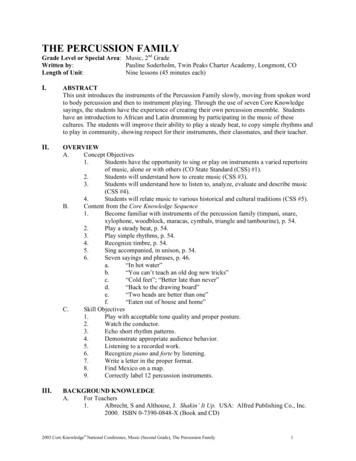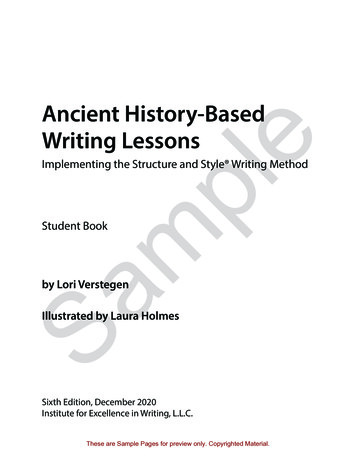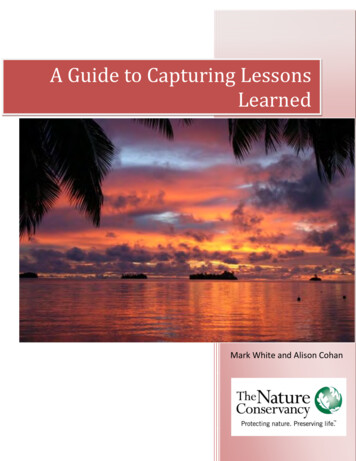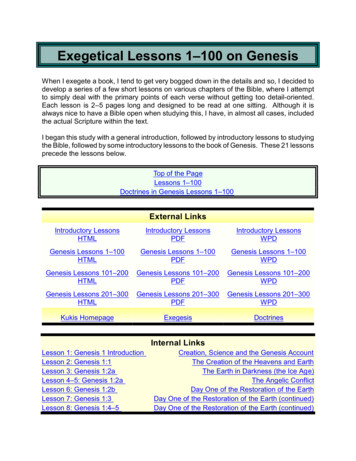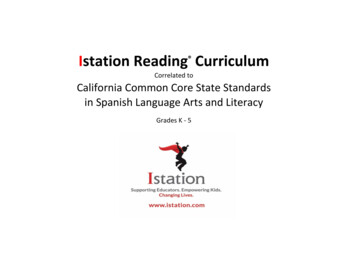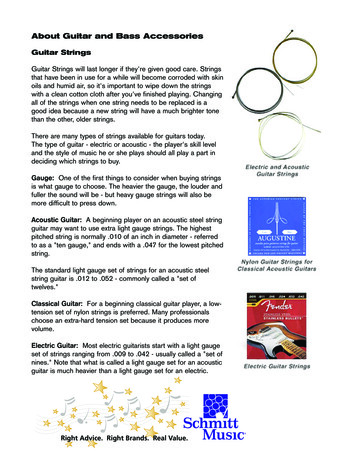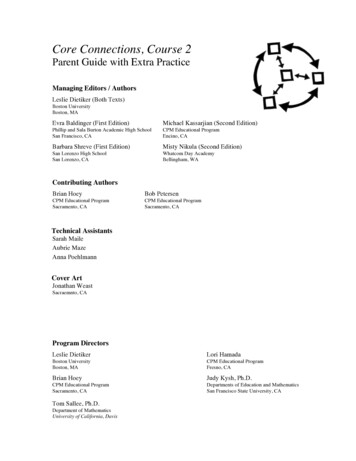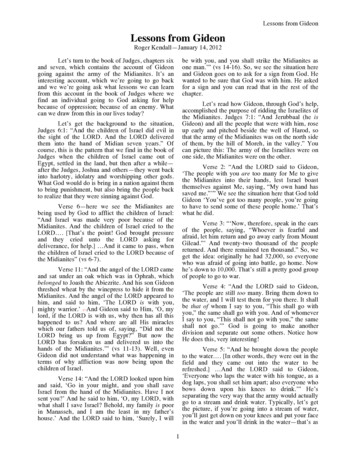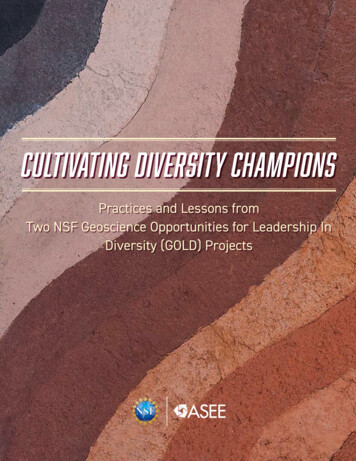
Transcription
Practices and Lessons fromTwo NSF Geoscience Opportunities for Leadership InDiversity (GOLD) Projects1Cultivating Diversity Champions: Practices and Lessons fromTwo NSF Geoscience Opportunities for Leadership In Diversity (GOLD) Projects
Founded in 1893, the American Society for Engineering Education (ASEE) is a global society of individual, institutional, and corporate members.ASEE seeks to be the pre-eminent authority on the education of engineering professionals by advancing innovation, excellence, and access at alllevels of education.ASEE engages with engineering faculty, business leaders, college and high school students, parents, and teachers to enhance the engineeringworkforce of the nation. We are the only professional society addressing opportunities and challenges spanning all engineering disciplines, workingacross the breadth of academic education, research, and public service. We support education at the institutional level by linking faculty and staff across disciplines to create enhanced student learningand discovery.We support education across institutions by identifying opportunities to share proven and promising instructional practices.We support education locally, regionally, and nationally by forging and reinforcing connections between academia, business,industry, and government.We support discovery and scholarship among education researchers by providing opportunities to share and build upon findings.We support innovation by fostering the translation of education research into improved teaching practices.We support disciplinary technical researchers by disseminating best research management practices.www.asee.orgCultivating Diversity Champions: Practices and Lessons from Two NSF Geoscience Opportunities forLeadership In Diversity (GOLD) Projects 2020 by the American Society for Engineering Education. All rights reserved.American Society for Engineering Education1818 N Street NW, Suite 600Washington, DC 20036This report is available for download at www.asee.org.ISBN: 978-0-87823-250-5Suggested citation:American Society for Engineering Education. (2020). Cultivating Diversity Champions: Practices and Lessons from Two NSF GeoscienceOpportunities for Leadership In Diversity (GOLD) Projects. Washington, DC.This project was supported by the National Science Foundation under award GEO-1623688 to the American Society forEngineering Education. Any opinions, findings, conclusions, or recommendations expressed in this publication are thoseof the author(s) and do not represent the views of the ASEE Board of Directors, ASEE’s membership, or the NationalScience Foundation.
AcknowledgementsASEE would like to acknowledge many contributors to this publication.Grantees from two Geoscience Opportunities for Leadership in Diversity (GOLD) projects provided thesubstance on which this publication is based. Rebecca Batchelor, Robert Kirsch, Brenee King, Sennai Habtesand John Crockett wrote Chapter 2. Jason A. Chen, Anna Strasshoffer, Brian J. Teppen, Jerlando F.L Jackson,Dena Samuels and Carolyn Brinkworth wrote Chapter 3. We are also grateful to Carolyn Brinkworth, GradyDixon, Darrin Pagnac, and Corey Garza for their input in the early ideation of this publication.The following ASEE staffers made contributions: Kacey Beddoes1, Learning and Instruction Specialist,drafted the initial outline and wrote the introduction chapter. Eric Wallace, Senior Project Manager, servedas managing editor, overseeing the publication process. Rocio C. Chavela Guerra, Director of Educationand Career Development, served as project director. Mark Matthews, Editorial Director, and Mary Lord,Deputy Editor, edited and proofread the document. Francis Igot, Senior Graphic Designer, designed thecover and layout.1Kacey Beddoes currently serves as Project Director at San Jose State University
Table of ContentsExecutive Summary. 1Chapter 1 - Introduction.2Overview.2Overview of the GOLD Projects.3Further information and Resources.7References.7Chapter 2 - Using Computer Simulations to Broaden Participation in theGeosciences: GeoDES.8Intervention Overview.8Theory.8Learning Objectives.9Simulation Goals and Materials.9Educational 2Environment.12Schedule.12Planned Changes.12Unplanned Changes.13iCultivating Diversity Champions: Practices and Lessons fromTwo NSF Geoscience Opportunities for Leadership In Diversity (GOLD) Projects
Attendance.13Processes Used to Determine if Intervention was Delivered as Planned.13Schedule and Delivery of Educational Intervention.13Outcomes.14Biggest Challenges.14Lessons Learned.15Recommendations and Best Practices For the Larger STEM Community.17Acknowledgments.18References.19Chapter 3 - A Team Approach to Building Diversity and Inclusion in theGeosciences: Sparks for Change. 21Intervention.21Theory.22Learning Objectives.23Materials.24Educational Strategies.25Incentives Provided to Schedule.26Planned Changes.27Cultivating Diversity Champions: Practices and Lessons fromTwo NSF Geoscience Opportunities for Leadership In Diversity (GOLD) Projectsii
Unplanned sons Learned.30Recommendations and Best Practices for Those Seeking to Create Similar Programs.31Recommendations for Chairs and ter 4 - Conclusion. 34AppendicesAppendix 1 - Resources for Culture Change- Handouts and Posters fromSparks for Change.35Appendix 2 - Leadership for Broadening Participation Podcast Transcript.40iiiCultivating Diversity Champions: Practices and Lessons fromTwo NSF Geoscience Opportunities for Leadership In Diversity (GOLD) Projects
Executive SummaryThe United States needs a diverse scientificworkforce in order to tap fresh thinking and talentneeded to advance the country’s competitiveedge and economic well-being. This is particularlytrue in the geoscience fields, where women andpeople of color have been underrepresented fordecades. Geoscience expertise is crucial to weatherforecasting, sea commerce, air safety, protectingcommunities from wildfires and many otherapplications.The National Science Foundation’s GeoscienceOpportunities for Leadership in Diversity, whichran from 2016 to 2019, sought ways to improvediversity, inclusion and equity in the geosciences.Its five projects took different approaches, butall faced common challenges as they developedmodel activities to guide the diversification ofthe geosciences. One key challenge was thewidespread belief among geoscience faculty that“science is science”, and that the question of whogets to practice geoscience is answered using thescientific method. The key lesson learned was thatgreater levels of diversity, equity and inclusion inthe geosciences will not happen unless the timeand effort spent diversifying the geosciencescounts for tenure and promotion. Any institutionwishing to recruit and retain top talent will find itsefforts thwarted unless it creates an environmentin which its champions for greater diversity inthe geosciences can pursue diversity, equity andinclusion work and thrive professionally.Cultivating Diversity Champions: Practices and Lessons fromTwo NSF Geoscience Opportunities for Leadership In Diversity (GOLD) Projects1
Chapter 1 - IntroductionOverviewThe geosciences do not look like the societythey serve. Like many engineering and otherSTEM disciplines, geoscience fields suffer from alack of engagement, recruitment, and retentionof people of color, women, LGBTQ individuals,and people with disabilities (Levine et al., 2007;Mattox et al., 2008; Stokes, et al., 2007, 2015).Indeed, National Science Foundation data showthat since 1966, the geosciences have graduatedfewer bachelor’s, master’s, and Ph.D. students thanany other STEM field (Huntoon & Lane, 2007).In atmospheric sciences, for instance, women’sparticipation in undergraduate degrees averagedroughly 23 percent between 1998 and 2008(Canetto et al., 2012), and in 2013 women madeup about 30 percent of the geoscience workforce(Stokes et al., 2015). Rates for people of color aremuch lower (Baber et al., 2010). Only 7 percent ofbachelor’s degrees, 5 percent of masters’ degrees,and 2 percent of doctoral degrees in geosciencewere awarded to African-American, Hispanic,or Native American students in 2007, and thoseminority groups comprised only 4.4 percent ofthe geosciences workforce at that time (AmericanGeological Institute, 2008; National ScienceFoundation, 2007).Many programs at the K-12 and college levelhave tried to address this problem. For example,there have been field-based programs createdfor Native American adolescents (Unsworthet al., 2012), summer camps for middle schoolminority students (Sherman-Morris et al., 2017),recruitment efforts by individual universities(Serpa, 2007), and community based researchprojects (Murray et al., 2012). Several reportshave synthesized best practices for broadeningparticipation in geosciences (Huntoon & Lane,2007; Pandya et al., 2007), including specificallyfor students with disabilities (Carabajal et al., 2017).Additional articles on diversity initiatives in thegeosciences can be found on the GOLD n 2016, the National Science Foundation created anew program aimed at addressing the lack of diversityin geosciences. The program was titled GeoscienceOpportunities for Leadership in Diversity (GOLD).Five GOLD projects—ASPIRE, FIELD, GeoDES, Heartsof Gold, and Sparks for Change—were funded. TheGOLD projects originated from a 2016 GeoscienceIdeas Lab organized by the American Society forEngineering Education. A detailed report about theIdeas Labs can be read 06/2016-Ideas-Lab-Report-28highres.29-1.pdfThough they differed in approach, all five projectswere united by a focus on increasing diversity, equity,inclusion, and social justice in the geosciences. Anoverview of each project is provided in the followingsection.The remaining chapters provide detailed accountsof the GeoDES, and Sparks for Change projectsand are written for STEM audiences outside of thegeosciences to learn from. Each chapter includesa description of what the teams did, the biggestchallenges they encountered, lessons learned, andbest practices developed. A modified version of theGuideline for Reporting of Evidence-based PracticeEducational Interventions and Teaching (Phillips etal., 2016) is used to report each project’s methods.A concluding chapter synthesizes the findings andoutcomes.Additionally, the handbook features two appendices.Appendix 1 consists of handouts describing differenttypes of leadership and informational posters with usefuladvice for people leading culture change programs andpeople supporting URM faculty members.Appendix 2 is a transcript of the introductory episodeof the Leadership for Broadening ParticipationPodcast Series. This transcript is included tointroduce readers to general issues of discussion inbroadening participation in the geosciences.ASEE’s aim in producing this handbook is todisseminate the knowledge gained through the GOLDprojects to a wider STEM audience and to identifypractices and lessons that other fields can adopt.2Cultivating Diversity Champions: Practices and Lessons fromTwo NSF Geoscience Opportunities for Leadership In Diversity (GOLD) Projects
Overview of the GOLD ProjectsASPIREActive Societal Participation in Research andEducation (ASPIRE) aimed to cultivate a generationof geoscientists with the leadership knowledge andskills, scholarship, and material support to reframeand rebrand the geosciences as socially relevant,and to broaden participation in these fields. Thesegeoscientists will do so by bridging long-standingdivides that impede access to and inclusion in thegeosciences: between basic and applied science,between scholars in the academy and membersof historically marginalized communities, andbetween the places where science is needed andthe places where it is typically conducted. To bringabout these types of change, ASPIRE drew upon,refined, and institutionalized the working groupmodel as the Mobile Working Group (MWG). Ledby a geoscientist with one foot in the academy andthe other in the community—the “gate opener”—each MWG focused on a single issue linked to onecommunity. ASPIRE supported multiple MWGsworking across the geographic, ethnographic, and“in practice” community space, as well as acrossthe body of geoscience research and application.Leadership team: Corey Garza, Principal Investigator, CaliforniaState University, Monterey Bay Lora Harris, Co-PI, University of MarylandCenter for Environmental Science –Chesapeake Biological Laboratory Julie Posselt, Co-PI, University of tive-societalparticipation-research-and-education3
FIELDGeoDESThe Fieldwork Inspiring Expanded Leadershipfor Diversity (FIELD) project made field activityin the geosciences more accessible and inclusiveby equipping field leaders with perspectives andskills to recognize and reduce common barriersin field settings. The project team convened animmersive leadership-development institute forfield scientists to engage in practical skills training(e.g., bystander intervention, managing crosscultural relationships) and collaboratively developnew approaches that could be implemented intheir own field experiences. The goal of the projectwas to understand the nature of field culture andhow field activity can be exclusionary, and toexplore potential solutions, with the long term aimof reducing the exclusionary nature of field culture.GeoDES tested new research-based methods forproviding professional development in equity andinclusion for geoscientists using mixed-realityrole-play simulations designed to teach the cohortto recognize prejudice and effectively intervenein geoscience-specific scenarios. The GeoDESleadership curriculum harnesses these new skills byfocusing them on institutional work to minimize theeffects of prejudice on gatekeeping decisions. Theproject used principles from social-cognitive theoryand social-closure theory to provide professionaldevelopment for a cohort of geoscientists to 1)increase their knowledge of prejudice and socialjustice issues relevant to the geosciences; 2)engage in bystander intervention techniques usinginteractive, mixed-reality simulations to learn howto counteract prejudice; 3) develop their leadershipskills to target critical gatekeeping decisions as astrategy to transform their own home institutions;and 4) support their continued development intochampions for diversity, equity, and inclusion.Leadership team: Darrin Pagnac, Principal Investigator, SouthDakota School of Mines and Technology Gillian Bowser, Co-PI, Colorado StateUniversity Peggy Fong, Co-PI, University of California–Los Angeles Mary Hubbard, Co-PI, Montana StateUniversity Anne-Marie Nunez, Co-PI, Ohio StateUniversity Julie Posselt, Co-PI, University of SouthernCalifornia Wendy F. Smythe, Co-PI, National ScienceFoundation Lisa D. White, Co-PI, University of CaliforniaMuseum of Paleontology Carolyn Brinkworth, Collaborator, UniversityCorporation for Atmospheric -project4Leadership team: Jason A. Chen, Principal Investigator, Collegeof William and Mary Brentt Brown, Co-PI, Mursion Inc. Heather Houlton, Co-PI, AmericanGeosciences Institute Jerlando F. L. Jackson, Co-PI, University ofWisconsin–Madison Justin Byron Richardson, Co-PI, University ofMassachusetts–Amherst Brian J. Teppen, Co-PI, Michigan StateUniversity Carolyn Brinkworth, Co-PI, UniversityCorporation for Atmospheric s-projectCultivating Diversity Champions: Practices and Lessons fromTwo NSF Geoscience Opportunities for Leadership In Diversity (GOLD) Projects
Hearts of GOLDSparks for ChangeThe goal of Hearts of GOLD was to help leaders ingeosciences become champions for diversity. Manyof the most established geoscientists have historiesof promoting and mentoring colleagues andstudents from underrepresented groups, but theyrarely are outspoken about this practice becausetheir expertise and experiences are not relatedto diversity. This project brought together thosegiants in the field in an effort to teach them thetools and skills needed to become champions fordiversity in the greater interest of the geosciences.The diversity of faculty in the geosciences remainsfar below that of the population as a whole, and thishas an effect on attracting and retaining a diversestudent body. The NSF-Geoscience Opportunitiesfor Leadership in Diversity Sparks for Changeprogram focused on improving the retention ofunderrepresented faculty in STEM using smallgroup theory to overcome institutional inertiatoward broadening-participation efforts. Oneunderlying reason for this inertia may be tenure andpromotion policies that offer little departmentalmotivation to recognize and reward efforts tobroaden participation. The result is a departmentalculture that does not view broadening participationefforts as important, and an environment in whichunderrepresented minority (URM) faculty may notfeel supported.Leadership team: P. Grady Dixon, Principal Investigator, FortHays State University Kathy Quardokus Fisher, Co-PI, FloridaInternational University Eric K. Kaufman, Co-PI, Virginia Tech LaToya Myles, Co-PI, National Oceanic andAtmospheric Administration Denise R. Simmons, Co-PI, University ofFlorida Carolyn Brinkworth, Co-PI, UniversityCorporation for Atmospheric ks for Change targeted these challenges with“triads” that brought together the experienceand broadening-participation values of an earlycareer minority faculty member (the Spark), asupportive later-career faculty member in thesame department (the Partner), and an externalbroadening-participation expert (the Sponsor),within a multi-institutional supportive cohort.Participants in the Sparks for Change Institute,held in Boulder, Colo., in September 2017, wereempowered with leadership training specific to theirrole in the triad and department and supported indeveloping action plans for changing the cultureof their own department. They remain connectedthrough a supportive community of practice. Sparksfor Change has produced indications of a growth inleadership capacity, mentoring of Sparks, and interinstitutional collaboration toward cultural change.Cultivating Diversity Champions: Practices and Lessons fromTwo NSF Geoscience Opportunities for Leadership In Diversity (GOLD) Projects5
Leadership team: Robert Kirsch, Prinicpal Investigator,Arizona State University Rebecca Batchelor, Co-PI,University Corporation for AtmosphericResearch/University of Puerto Rico Humacao John Crockett, Co-PI, San DiegoState University Sennai Habtes, Co-PI, University of theVirgin Islands Brenee King, Co-PI, Kansas State UniversityPublications:Kirsch, R. (2018). Focusing on leadership toimprove diversity in the geosciences. Eos, 99.Posselt, J. R., Chen, J., Dixon, P. G., Jackson, J. F.,Kirsch, R., Nuñez, A. M., & Teppen, B. J. (2019).Advancing inclusion in the geosciences: Anoverview of the NSF-GOLD program. Journal ofGeoscience Education, 67(4), 313-319.Batchelor, R., Kirsch, R., King, B., Habtes, S., andCrockett, J. (2018, January). Sparks for Change:Supporting and retaining minority facultyin the geosciences. Paper presented at theannual meeting of the American MeteorologicalSociety. Austin, Texas. per328335.html)Kirsch, R., and Batchelor, R. (2017, December).Small Groups, Big Change: Preliminary findingsfrom the Sparks for Change Institute. Paperpresented at the annual meeting of theAmerican Geophysics Union. New Orleans,Louisiana. per/239469)King, B. (2017, November) Leadership Strategies forEquity and Inclusion in the Geosciences, AGU/AGI Heads and Chairs webinar nce Presentations:Batchelor, R., Crockett, J., Habtes, S., King, B.,and Kirsch, R. (2019, November). Sparks forChange: Advancing leadership for broadeningparticipation. Short course presented at theAssociation of American Colleges & Universities’Transforming STEM Higher Educationconference. Chicago, Illinois. ops)Kirsch, R. (2019, May). Solidarity in the PublicRealm: Non-constituted leadership for socialchange. Paper presented at the annual meetingof the Public Administration Theory Network inDenver, Colorado.Batchelor, R., Kirsch, R., King, B., Habtes, S.,and Crockett, J. (2019, February): Sparks forChange: Developing DEI Change Agents in theGeosciences. Paper presented at the Associationfor Sciences of Limnology and Oceanography.San Juan, Puerto Rico. -ProgramBook-with-addendum.pdf)6Cultivating Diversity Champions: Practices and Lessons fromTwo NSF Geoscience Opportunities for Leadership In Diversity (GOLD) Projects
Further information and Resources GOLD projects homepage:https://cpaess.ucar.edu/gold Leadership for Broadening ParticipationPodcast Series: participationpodcast-series/ReferencesAmerican Geological Institute (2008). Guide togeoscience careers and employers. Retrievedonline September 1, 2008 athttp://www.agiweb.org/workforceAnderson, E., & Kim, D. (2006). Increasing thesuccess of minority students in science andtechnology.Baber, L. D., Pifer, M. J., Colbeck, C., & Furman, T.(2010). Increasing diversity in the geosciences:Recruitment programs and student self-efficacy.Journal of Geoscience Education, 58(1), 32-42.Carabajal, I. G., Marshall, A. M., & Atchison, C. L.(2017). A synthesis of instructional strategiesin geoscience education literature thataddress barriers to inclusion for students withdisabilities. Journal of Geoscience Education,65(4), 531-541.Canetto, S. S., Trott, C. D., Thomas, J. J., & Wynstra,C. A. (2012). Making sense of the atmosphericscience gender gap: Do female and malegraduate students have different careermotives, goals, and challenges? Journal ofGeoscience Education, 60(4), 408-416.Huntoon, J. E., & Lane, M. J. (2007). Diversity inthe geosciences and successful strategies forincreasing diversity. Journal of GeoscienceEducation, 55(6), 447-457.Levine, R., González, R., Cole, S., Fuhrman, M., & LeFloch, K. C. (2007). The geoscience pipeline: Aconceptual framework. Journal of GeoscienceEducation, 55(6), 458-468.Mattox, S., Bridenstine, M., Burns, B., Torresen, E.,Koning, A., Meek, S. P., . Waters, T. (2008). Howgender and race of geologists are portrayedin physical geology textbooks. Journal ofGeoscience Education, 56(2), 156-159.Murray, K. S., Napieralski, J., Luera, G., ThomasBrown, K., & Reynolds-Keefer, L. (2012).Broadening diversity in the geosciences throughteacher–student workshops that emphasizecommunity-based research projects. Journal ofGeoscience Education, 60(2), 179-188.National Science Foundation. (2007). IntegratedScience and Engineering Resources Data System.Pandya, R. E., Henderson, S., Anthes, R. A., &Johnson, R. M. (2007). BEST practices forbroadening participation in the geosciences:Strategies from the UCAR SignificantOpportunities in Atmospheric Researchand Science (SOARS ) Program. Journal ofGeoscience Education, 55(6), 500-506.Phillips, A. C., Lewis, L. K., McEvoy, M. P., Galipeau,J., Glasziou, P., Moher, D, Williams, M.T. (2016).Development and validation of the guideline forreporting evidence-based practice educationalinterventions and teaching (GREET). BMCmedical education, 16(1), 237.Serpa, L., White, L., & Pavlis, T. L. (2007).Recruiting and graduating minoritygeoscientists from the University of NewOrleans. Journal of Geoscience Education,55(6), 560-566.Sherman-Morris, K., Clary, R. M., McNeal, K
bachelor's degrees, 5 percent of masters' degrees, and 2 percent of doctoral degrees in geoscience were awarded to African-American, Hispanic, or Native American students in 2007, and those minority groups comprised only 4.4 percent of the geosciences workforce at that time (American Geological Institute, 2008; National Science


